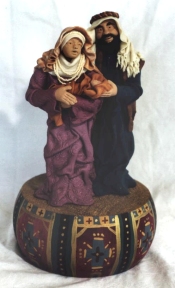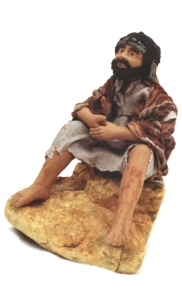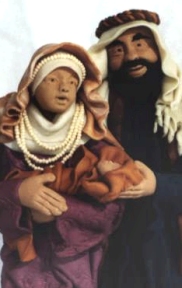| | Saints and Angels:
Images of Faith in Polymer Clay
By Judy Gibson King Art, throughout recorded history, has been a means of expressing personal and corporate faith. Early people used art as a form of communication with the Great Spirit that held power over their world. Later, people used art to teach the stories of scripture. Today, we adorn our churches with numerous symbols of our faith. Religious art spans cultures and centuries and continents. It enriches us, inspires us, motivates us and soothes us. If our hearts and minds are open, it can speak to us: from the small simply carved Venus of Willendorf to the exquisite marble statues of Greek gods; from the powerful lines of color that cover cave walls in Lascaux to the glory of the Sistine Chapel; from the soaring heights of Gothic cathedrals in Europe to the graceful simplicity of the adobe mission churches in the American southwest. Images of faith speak to us in a common language.
My journey with religious art began many years ago in the darkened slide room of a university art history class. In the images that flashed on the screen, I saw a visual faith history of the people of God. My interest in – and inspiration from – those images is with me today as I work sculpting colorful saints, angels and nativity figures from polymer clay.
These sculptures began as a form of private meditation and prayer, growing into a full time endeavor. The figures are small enough to fit comfortably in the palm of your hand. Never a painter but always wanting to play with color, I find I can “paint” with the clay. It comes in a myriad of colors that can be mixed, blended, swirled, or pressed into an unending array of hues and textures.
Inspiration for the figures comes in a variety of ways. Each piece is carefully researched in art history, biblical texts and commentaries, and, in some cases, by reading the works of the saint or figure whose likeness I am sculpting. I enjoy seeing the ways a particular saint appeared in art in other times and places. Did he or she show up more often in stained glass or carved into a column? Were they shown alone or with others in story form? Did they appear mostly at the front door of the church or did they adorn the walls and niches inside? The more I learn, the more the pieces change.
However, the clay doesn’t always reflect what I’ve read or seen. I find that images of the respective saints come out differently each time. Some of these differences are attributed to the music playing in the background as I work. At times the studio is filled with the solemn tones of Orthodox chants; on other occasions the walls reverberate to the lively tunes of old-time Gospel favorites. Some differences come from comments I hear when I exhibit my work. Frequently, after carefully and pensively examining a piece, people tell me about a personal faith experience that is brought to mind by the small sculpture they hold in their hand. Sometimes these stories are told with tears, at other times with smiles. These personal stories, without my realizing it until much later, often influence subsequent images of the particular saint or biblical figure.
The face is the starting point of each piece I make. Once the face is complete, the clay lets me know whether or not it is going to become the person I started out to make. Many times I’ve begun work on a Saint Francis only to discover that the piece is going to be someone else. It is as if the clay has a mind of its own. Often, the unintentional aspect of the piece is what appeals to those who see it.
People describe my work as whimsical or joyful, and they are often surprised by the nontraditional presentation of traditional images and themes. Mary and Joseph are never kneeling in adoration of the Christ Child. Instead, Mary may be curled up asleep with her head in Joseph’s lap while he cradles the child in his arms. Sometimes both Mary and Joseph sleep while an angel baby-sits. The Three Magi never carry gifts of gold, frankincense or myrrh; instead, they fall to their knees and hug each other in joyful adoration of the child before them. Our Lady of Guadalupe smiles gently as she holds out a golden tilma filled with red roses. A large purple and green snake coils gently around Eve and whispers in her ear as she sits in a bed of flowers and munches on an apple. Joseph, clearly a favored child, twirls with his arms outstretched, reveling in his new coat of many colors. Saint Francis leans against a rock, hands clasped behind his head, while a cat sleeps on his lap. Abraham’s wife, Sarah, dressed in purple, caresses her newborn son against her cheek. The woman at the well struggles to pull her vessel up onto her shoulder. Angels laugh and shepherds doze. Jonah clings to the lips of a giant goldfish to keep from being swallowed. The stories and people spring from the pages of the Bible and burst forth in colorful abandon on my clay table. They make me laugh. They bring me joy. They remind me of the presence of God in our lives – through the good times and the bad.
Prayer is an integral part in the creation of these little clay saints and angels. Prayers are offered before work begins. The research is finished. Music is turned on and a candle or incense is lit. The clay is conditioned and begins to take shape. It is a time of quiet concentration for me, a time to be still and listen to the heartbeat of God. Someone once looked at a display of my clay work and said they appeared to be “visual prayers.” I like that description.
Polymer clay is a very user-friendly art medium, which requires no special tools or equipment. I roll the clay out on a slab of marble purchased at a kitchen supply store and use marble coasters as a temporary base for each piece. Simple aluminum foil is compressed and shaped into whatever armature is needed. The body is sculpted
from various colors of clay that I blend for each individual. I carve the small details using toothpicks, nail files, cuticle scissors, and a nut picker. A pasta machine is used to roll out thin sheets of clay that are draped in multiple layers over the body to form clothing.
Polymer clay doesn’t dry out, it sticks to itself without the use of slip, and it doesn’t require a kiln. The finished pieces can be baked in an ordinary kitchen oven. Due to the strong fumes emitted by the clay during baking, it is best to have an alternative-cooking source that is not used for food preparation. I bake my sculptures in an electric turkey roaster that I use exclusively for this purpose.
Polymer clay can be purchased at any art and craft supply store or over the Internet. Different brands have unique qualities and produce varied results. The clay can be tinted with powders before baking or painted with simple acrylic paint after baking. Different manufacturers have different baking directions. Always follow the directions on the package and never exceed the recommended baking temperature. If the oven is too hot, the clay will burn, and the result is a stinky, ugly mess. I’ve experimented with different baking times and find (for my work) that a slightly longer than recommended time works best. I also leave the oven closed until it is completely cool before removing any of the pieces.
The main piece of advice I give during my workshops is to relax and have fun with the clay. No matter how many pieces I make, each one is a new challenge and learning experience. I love working with these little clay people. They are joyful images, exuberant expressions of sacred narrative. | | 
Holy Family 
John the Baptist 
Our Lady of Guadalupe 
Women at the Tomb 
Detail
Holy Family | |
![]()